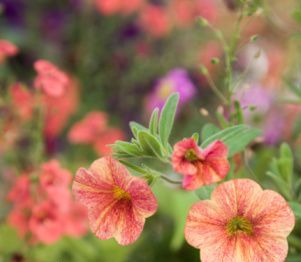Petunias are popular summer flowers that are loved for their minimum care needs and lovely looks. They flower profusely and look beautiful in beds, planters, windowsills, containers and hanging baskets too. They are presumed to be annual plants but are almost perennials.
Native to South American countries like Brazil and Argentina, the petunias captured the fancy of the explorers who took seeds back with them to their home countries.
 Petunia plants grow to a height of 12-15 inches and the stem and plant have soft hair all over.
Petunia plants grow to a height of 12-15 inches and the stem and plant have soft hair all over.
The colorful blooms are funnel shaped and are available both as single and multicolor flowers. Easy to grow, these flowers add a lot of color to the garden.
Petunias grow from seeds and can be grown directly in the flower beds.
If you would like spring blooms you can plant them indoors about 6-8 weeks before last frost date, and then transplant the young plants in their beds at a later date.
If your region is very hot, you may consider growing petunias in partial shade.
When planting petunia directly into beds, remember that the seeds need sun to germinate, so just sprinkle the seeds on the top soil, and pat them down for best germinating conditions.
You may like to use the heated germinating mat, to increase the rate of germination.
When planting seeds, one can arrange the different colors in a pattern or throw them together for a colorful bouquet. Remember to add some general fertilizer when planting and then repeat every month thereafter.
Petunias don’t need much water but all the same they will not like long dry spells either. They need regular weeding and a little much goes a long way. A little pinching when the plants are still growing will lead to better plants.
Also if the plants go gangly, you may consider pinching the plants to make them branch out more. Also it is essential to deadhead the dead blooms to encourage better blooms. The petunias will continue to bloom even after the first light frost, but a hard freezing frost will spell the end.
Petunias are sturdy plants and need little care. They are not prone to diseases and are pest resistant. Still you may want to take care of the soft rot and gray mold that may be a problem if you have a rainy climate. You could avoid it by choosing rain resistant petunia varieties.
In case of aphids, a strong jet of water will do the trick. Petunias are prone to budworm caterpillars but the problem subsides by July. If the infestation is severe, you can use Bt on them.
The oldest types of petunias that are loved are the multifloras and the grandifloras. True to their name grandifloras have larger flowers while the multifloras stand well in the rain. They are both mound varieties.
The Supertunia, Surfinia, Cascadia and Wave are spreading petunias and don’t require deadheading too. Million Bells and calibrachoa look like tiny petunias but are a different species altogether.
Some new varieties that are gaining ground are Blue Spark Cascadia with its violet blooms and sweet smell, Supertunia Silver, boasting white blooms with lavender veins and throat, Prism Sunshine with buttery yellow large flowers all with very good weather tolerance.









Comments are closed.